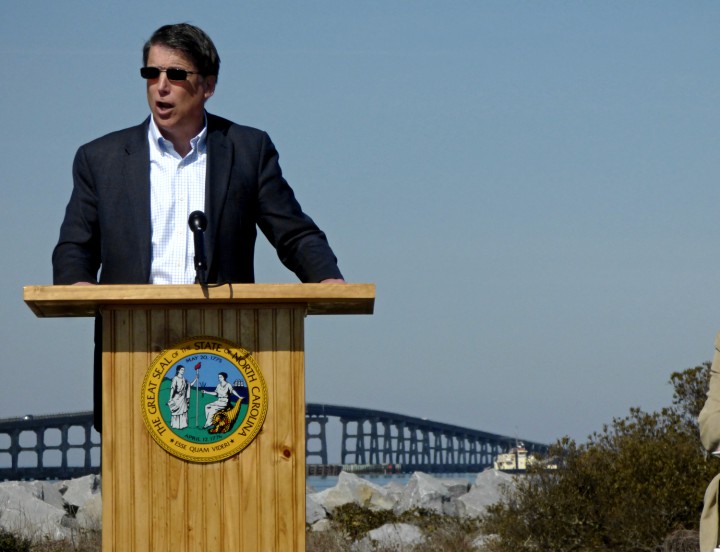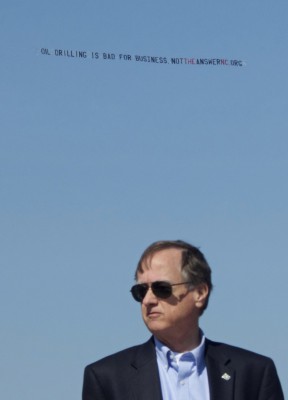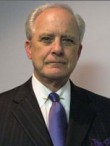
NAGS HEAD — Delayed for decades by funding shortages, bureaucratic showdowns and seemingly endless lawsuits, Tuesday’s groundbreaking for the replacement bridge over Oregon Inlet is a day many frustrated Dare County residents thought they’d never live to see.
Supporter Spotlight
“I’ve been worrying about it for a very long time,” said Beth Midgett, a 49-year-old Hatteras resident who founded a group a decade ago that pushed to get the bridge built. “I do feel like the grassroots efforts put a face on what Bonner Bridge meant. It wasn’t just a structure – it sounds like a cliché, but it was our lifeline. We were literally scared to death that they would study this to death.”
Clear blue skies and pleasant spring temperatures added to the celebratory atmosphere at a mid-morning press conference Gov. Pat McCrory held at the north end of Pea Island, with the 53-year-old Herbert C. Bonner Bridge as a backdrop.
Wearing sunglasses and an open-collared shirt and jacket, McCrory put his notes aside and spoke about when he first came to Oregon Inlet, how struck he was at how personal the Bonner Bridge was to residents of Dare County.
“It was personal because not having this bridge would impact their livelihoods, “ McCrory said. “It’s personal when it’s a public safety issue. It’s personal when we’re talking about economic development.”

McCrory, a Republican who is seeking a second term in November, blamed a “small group of people” for blocking the project for years through litigation.
Supporter Spotlight
The state Department of Transportation and the Federal Highway Administration reached a settlement in July 2015 with environmental groups the Defenders of Wildlife and the National Wildlife Refuge Association, represented by the Southern Environmental Law Center.
The settlement was a result of nine months of negotiation and ended a July 2011 lawsuit filed to stop DOT’s plan to replace the bridge with a parallel span and address problems on N.C. 12 south of the bridge as needed. The environmental groups favored a 17.5-mile bridge that would have bypassed Pea Island National Wildlife Refuge, but the groups agreed to drop the legal action in exchange for DOT agreeing to consider building bridges out into Pamlico Sound to bypass sensitive areas in the refuge.
“We had to find a common-sense solution to make this long-delayed project become a reality,” McCrory said.
The $246 million, 3.5-mile replacement bridge will be built by contractors PCL Civil Constructors Inc. and HDR Engineering Inc. of the Carolinas.
“It’s going to be a beautiful bridge,” McCrory said, “and it’s going to be one that will improve the quality of life.”
As the governor addressed the small crowd of Outer Bankers and local, state and federal officials, a plane circled overhead at least 10 times, trailing a banner that said: “Oil Drilling is Bad for Business. Not the Answer NC.org”

McCrory later declined to comment on whether he still favored oil and gas exploration off North Carolina, saying it was a day to celebrate. At least 27 coastal counties are opposed to drilling, and the federal government does not favor a plan to share any lease revenue with the Atlantic states.
“I’m not going to divert the attention off this incredible accomplishment,” McCrory said after the groundbreaking, adding that he did not notice the banner being flown above the site.
“The definition of politics to them is the art of diversion,” he said about the anti-drilling effort.
Several speakers lauded McCrory’s dedication to getting the project moving forward, although the governor said that the success was a product of effective teamwork on all levels of government.
“Were it not for Gov. McCrory,” said N.C. Transportation Secretary Nick Tennyson, “we would still be talking about a court case and not a new bridge.”
Tennyson said that maintenance costs for the aging bridge were “outrageous,” but the new bridge, which will take about three years to build, will be made with modern materials like reinforced stainless steel and updated piling designs that will ensure it lasts at least 100 years. It will also have seven, rather than one, spans open to navigation to make it safer for boat traffic.
A new interim $14.3 million concrete bridge is also being built farther south in Pea Island to replace a temporary metal bridge that was installed in 2011 after Hurricane Irene. The permanent bridge is still being planned.
More than 20 years beyond its useful lifespan, the Bonner Bridge replacement planning began in 1990, with the first environmental study completed in 1993. Plans repeatedly were thrown off course by regulatory and environmental challenges.

Rep. Walter Jones, R-N.C., said that the importance of Bonner Bridge to the people of the Outer Banks underscores why government needs to invest in projects at home, rather than overseas.
“This is a different county,” Jones said. “It’s a county that’s been blessed by God in so many ways.”
As the bridge got older and more decrepit, the community became more concerned. People who used the only link to Hatteras Island on a regular basis joked darkly that they opened their windows when they crossed the bridge in order to increase their chance of survival.
“With this new bridge, the people of Hatteras Island will have peace of mind,” said Bob Woodard, chairman of the Dare County Board of Commissioners. “The bridge is vital to our regional economy and the tourism industry.”

Jerry Jennings was dealing with the Bonner Bridge, whether getting it repaired or getting it replaced, even before his time as DOT division engineer, a position he has held since 2007.
“The bridge has really needed to get done for several years,” he said. “Certainly, in Division 1, it is one of the more complicated projects we have done.”
A lot has been learned in the 30 years since the first bridge was built, he said. The new bridge will alleviate many of the problems with navigation and dredging, as well as the constant worry about scour at the pilings and structural corrosion.
The new bridge’s seven spans will be 300 feet apart through the high rise and elevated for 3,500 feet from a little north of the existing span almost to the south side before sloping down. That will make the bridge much less susceptible to the whims of current and sand shifting that have created constant headaches with unpredictable shoaling and navigation of the channels in Oregon Inlet.
Harry Schiffman, owner of Salty Dawg Marine Towing and a waterman who has worked on Oregon Inlet issues for half of his 74 years, said that the wide spans on the new design makes the replacement bridge much less hazardous for commercial and recreational vessels that transit the notoriously treacherous waterway.
“This is a great day,” Schiffman said about the official kickoff of the project. “I wasn’t sure I would be here to see it.”








